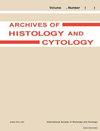大鼠肌纺锤体神经末梢GM1、GD1a、GD1b和GQ1b神经节苷脂的免疫组化定位
Q4 Medicine
引用次数: 2
摘要
肌肉纺锤体是由感觉神经和运动神经末梢共同支配的。感觉神经主要分布在肌纺锤体的赤道区,而运动神经则分布在极区。为了检测神经节苷脂在感觉神经末梢和运动神经末梢中的表达,我们研究了成年大鼠咬肌、尺侧腕屈肌和腰椎棘旁肌肌梭中GM1、GD1a、GQ1b和GD1b神经节苷脂的分布的地形差异。GM1、GD1a和GD1b广泛分布于肌纺锤体的感觉区和运动区,而GQ1b则局限于感觉区。GQ1b染色与背根神经节本体感觉神经元标志物小白蛋白比较,运动区神经末梢小白蛋白染色完全阴性,少数GQ1b阳性。GQ1b染色可反映极区II组感觉神经末梢的少量分布,抗GQ1b抗体可作为肌梭的感觉神经标记物。抗小白蛋白抗体可能作为假定的本体感觉(Ia组)神经标记物也存在于肌梭中。本文章由计算机程序翻译,如有差异,请以英文原文为准。
Immunohistochemical localization of the GM1, GD1a, GD1b and GQ1b gangliosides in the neuronal endings of rat muscle spindles
Muscle spindles are known to be innervated by both sensory and motor nerve endings. Sensory nerves are mainly distributed in the equatorial regions of muscle spindles, while motors are distributed in the polar regions. To examine the ganglioside expression in sensory and motor nerve endings, we investigated the topographical difference in the distribution of GM1, GD1a, GQ1b and GD1b gangliosides in the muscle spindles of masseter, flexor carpi ulnaris and lumbar paraspinal muscles of adult rats. Whereas GM1, GD1a and GD1b are distributed widely in both the sensory and motor regions of muscle spindles, GQ1b is restricted to the sensory regions. When GQ1b stain was compared with parvalbumin, known as a marker of proprioceptive neuron in dorsal root ganglia, parvalbumin staining was completely negative in the nerve endings of motor regions, whereas a few of them were GQ1b positive. GQ1b stain may reflect a few distribution of group II sensory nerve endings in the polar regions, and anti-GQ1b antibodies may be useful as a sensory nerve marker in muscle spindles. Anti-parvalbumin antibody may be used as a putative proprioceptive (group Ia) nerve marker also in the muscle spindle.
求助全文
通过发布文献求助,成功后即可免费获取论文全文。
去求助
来源期刊

Archives of histology and cytology
生物-细胞生物学
自引率
0.00%
发文量
0
期刊介绍:
The Archives of Histology and Cytology provides prompt publication in English of original works on the histology and histochemistry of man and animals. The articles published are in principle restricted to studies on vertebrates, but investigations using invertebrates may be accepted when the intention and results present issues of common interest to vertebrate researchers. Pathological studies may also be accepted, if the observations and interpretations are deemed to contribute toward increasing knowledge of the normal features of the cells or tissues concerned. This journal will also publish reviews offering evaluations and critical interpretations of recent studies and theories.
 求助内容:
求助内容: 应助结果提醒方式:
应助结果提醒方式:


